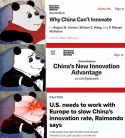@Tyler Bro Repost to the semiconductor thread so we can discuss and not deviate, sorry I can't find the list (all 16 of them) BUT I have here an excerpt from our esteem member
@superdog from his post 2 years ago (all his prediction is accurate to the tee, so Bro I hope you post more...lol) and an add bonus a mainland article about the 02 project.
antiterror13 said:
It doesn't say that the license is cancelled .... If it is it would force China to focus the resources to create similar technology and I have no doubt China would be successful doing it
Remember
* Top supercomputer after The US govt banned Intel to China .. China was in the top using its CPU
* Israel AWACS for China (stopped by the US) ... China developed KJ-2000, etc
* Arm embargo to China since 1989 ... Chinese indigenous weapon system developing so fast and now one of the most advanced
* CNC machine embargo ... you see who produce the most CNC? ..... yes China for about 80%
* Ban of China participation to Galileo ... China developed Baidou, now already global challenging GPS while Galileo still stuck
* Ban of China participation in ISS .... China go ahead with Tiangong 2 and soon Chinese large modular space station
* Etc, etc
* EUV embargo ...... guess what would happen ?
Click to expand...
Click to expand...
Climbing the lithography tech tree requires decades of intensive research work, reacting
after an embargo would be way too late.
The good news is that this has been in China's plans for decades.
The bad news is that the catch up game will still go on for many years, if not decades.
The saving grace is that if the semiconductor embargo intensifies, they will pour much more resources into this and catch up quicker.
is China's ASML, it has been working on lithography machines since the 10th 5-year plan (2001-2005). If you go to its website you can see its most recent lithography product (SSB600 series) supports ArF light source dry lithography. This was announced in 2016, and machines with similar specification are typically used for making chips with process nodes of 130-65nm.
The SSB600 series was not commercially successful and still depended on some important foreign components. It was more of a research milestone rather than a business one.
The current product being developed by SMEE is said to be the SSB800 series, which is an ArF light source
immersed lithography machine. This was funded by the "28nm node immersive lithography machine" topic, under the "02 project" and the 13th 5-year plan (2016-2020). Expected delivery is 2021. It can also be expected that the machine will have less foreign dependency, as local upstream suppliers (Beijing Guowang Optical Tech,
, Changchun Institute of Optics etc.) are providing key components such as the light source, the optical system, and the "dual wafer stage" design, all of which are sub-topics in the 02 project.
It is important to understand that one generation of lithography machine corresponds to multiple generations of chip process nodes. How far the machine can be pushed also depends on the technical know-how of the foundry. For example, SMIC owns the same model of ASML ArF immersed lithography machines that TSMC used to make 1st gen 7nm chips, but SMIC only just started 14nm production. Getting a great sculpting knife doesn't mean you can immediately become a great sculptor.
We don't know what is the process node limit of the SSB800 series. It is technically in the same generation of ASML's DUV machines that TSMC pushed up to 7nm, but that took the most advanced foundry and a much more mature lithography product line to achieve. My guesstimate is that for the SSB800, 28nm would be a good initial trial target (also required by the national plan), and 10-14nm should be within reach after some adjustment and improvement. 7nm is questionable, I think it depends on how long China will get stuck on DUV.
To go beyond 7nm, it is necessary up a generation and get EUV lithography machines. I heard they've made good progress in EUV light source (which is a key technical challenge), otherwise little is known about the progress of a domestic EUV machine. I don't expect to see it soon, but it is in their plan for sure.
The difficulty to catch up in semiconductor manufactoring must not be underestimated, and
China is one player that don't underestimate things. You know, the full name of the 02 project is "The project of manufacturing technology and complete sets of technology for very large scale IC's", but why do people call it the 02 project? Because it is considered the 2nd most important in all of China's 16 long term tech development projects.
To establish a complete domestic chip industry chain, it must have its own light source and lens. Therefore, the
02 special
project also established a ...
Quote Reply
Report Edit


